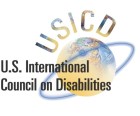The Visibility of Disability in Business
Joining USICD for the summer is intern Steven A. Rodriguez. Steven is a rising senior and Skadden, Arps honors scholar pursuing a B.A. in International Studies at The City College of New York of The City University of New York (CUNY) and holds an A.A. in Liberal Arts from Kingsborough Community College. He is aiming for law school next, with a focus on disability law and public policy.
Before USICD, Steven interned with the National Disability Rights Network where he first had the opportunity to participate in outreach for the CRPD. He has held student leadership roles at CUNY in various capacities, most notably in the CUNY Pathways initiative, a historic reform of the general education framework across CUNY’s 26 Colleges & Schools. In 2012, Steven became chairperson of the CUNY Coalition for Students with Disabilities, a not-for-profit, membership, student-led organization dedicated to increase awareness, opportunity and foster community amongst CUNY’s more than 9,000 students with disabilities. Please welcome Steven and reach out to him at srodriguez@usicd.org.
Businesses, accessibility experts, and human rights advocates all have a shared interest in enabling people with disabilities to use mobile phones and tablets—an interest they were able to advance at the recent 2013 M-Enabling Global Summit. The summit brought together U.S. and international government leaders, mobile service providers, and public and private sector organizations who support accessible and assistive mobile solutions in the global market. Participants shared experiences on how to best leverage the latest technologies to create life changing applications and services for seniors and users of all abilities, both locally and abroad.
Smart phones and tablets are expanding in the global marketplace, providing unique opportunities for businesses and organizations alike. Mobile internet traffic has more than doubled from 2010 to 2012. Over 50% of Americans have access to mobile phones, and people with disabilities are playing a more prominent role in mobile usage. There is an untapped portion of civil society that is looking for accessible options in order to live a more independent life. Thanks in part to the Convention on the Rights of Persons with Disabilities (CRPD) the shift towards accessibility in all aspects of life is now becoming a more realistic scenario in the world today.
The CRPD was drafted to promote a change in attitudes and approaches toward persons with disabilities. The CRPD had the highest number of signatories in history to a United Nations Convention on its opening day, with even stronger support for it today: as of June 10, 2013, 155 countries are signatories and 130 countries have ratified it. The CRPD was inspired by the Americans with Disabilities Act (ADA) and, through discussions by the global community, became the fastest negotiated human rights treaty. As more countries move towards ratification, accessible technologies will increasingly become the status quo.
The mobile device is being used for desktop tasks today more than ever before. Mobile technologies are being used for document management, an advanced stage of mobile device use. While mobile devices won’t necessarily replace the desktop any time soon, it does allow for more independence. Ph.D. Joyojeet Pal, Assistant Professor at University of Michigan, remarked how the use of social media expands a person’s social circle beyond the immediate area. The ability to engage and connect to other people is becoming more accessible in part due to internet technology. Mr. Eric Schmidt, President of Google, remarked at Google I/O 2013 how Google does a great job of connecting 2 billion people, and the next challenge will be to connect the remaining 4.5 billion people to the internet. Although billions of people remain beyond the reach of the internet, there are innovative forms of off-line digital storage technology like USICD’s Global Disability Rights Library (GDRL), through eGranary Digital Libraries, to reach people beyond the reach of the internet. In a similar manner, there are ways to provide independent communication channels with current phones like mesh networking that doesn’t require an existing network of cell towers. The capacity for mesh networking is already available in smartphones, and its application in emergency situations like Red Hook is even more remarkable.
There are more than 5 billion mobile phones, but only 1 billion smartphones in usage today. Despite the apparent gap, the rise in smartphone usage is growing at 42% a year globally. The convenience and utility of mobile devices increase their appeal and use by people with disabilities. Already Apple’s iOS has built in an unprecedented package of accessibility features into its operating system, setting the bar for what is possible when a device manufacturer commits to accessibility. What is more striking, however, are the current capabilities of phones already in circulation. Steve Jacobs, President of IDEAL Group, remarked how many of the mobile phones in developing countries and low resource environments have the capacity for mobile accessibility and features but don’t commonly promote or use them.
As more countries comply with the CRPD, a new wave towards accessible technologies and features will begin. Mobile devices in particular are capable of being accessible for people with disabilities with various features that are underutilized or not promoted effectively. What is important to take away from the conference is the need for technology to be accessible from the start, as @BA_Haller noted, “In this day and age, technology should be born accessible. No more excuses!”


I appreciate your inspiring initiatives. I want to raise awareness about the dire need for wheelchair ramps to facilitate movement of disabled/immobile people to engage in social activities. Please find below an excerpt from my article on the same for your reference. Thank you.
Disabled people exist in Pakistan the same way they exist in other countries around the world. Yet, disabled people are more ‘visible’ in other parts of the world as compared to Pakistan. In Pakistan, people who are unfortunately bound by immobility have no option but to stay ‘hidden’ and home-bound since they are not facilitated to access venues of social participation.
It is sad to see that there are no ramp provisions or facilitations for people in Pakistan who might be benefited by riding wheelchairs. In places like England, they have planned cities with the conscious awareness of laying down footpaths next to roads with ramps linking the two. Even their bus systems are designed such that people with wheelchairs can get on and off a bus quite easily.
On the contrary, in Pakistan, amazingly, there are no ramps for wheelchairs catered by most schools, restaurants, grocery stores, bookshops, mosques, pharmacies, shopping malls, movie theatres, public transport facilities, post offices, and so on, with only a handful of respect-worthy exceptions such as airports, a few universities, and perhaps some elitist socialising clubs. In the absence of ramps, where would the disabled people go?
Everywhere around the world, concerned public and private institutions should undertake the social responsibility of incorporating permanent or makeshift ramp provisions that could facilitate people with disabilities to participate in social activities.
http://sarahrehan23.blogspot.com/2013/07/wheelchair-ramps-in-pakistan-dire-need.html